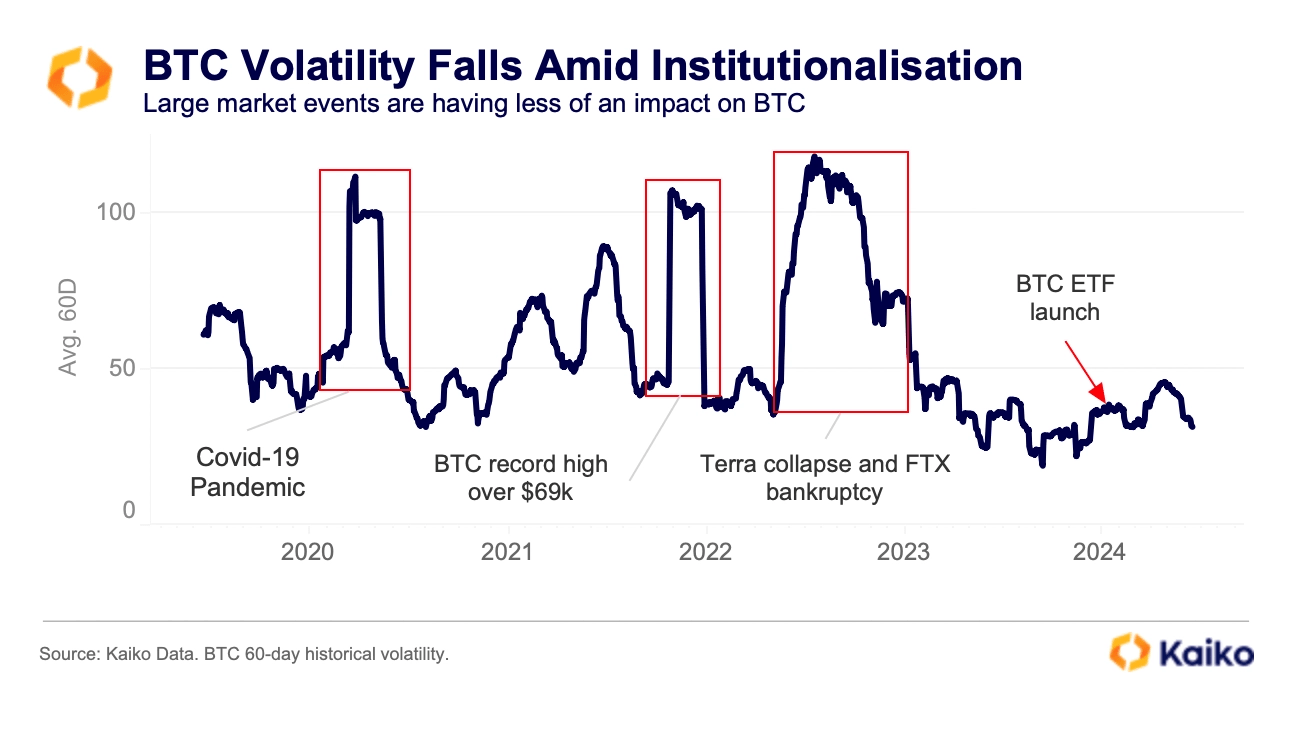Bitcoin reduced volatility points to market growth and institutional influence

Bitcoin’s (BTC) recent price movements reflect a newfound stability in the crypto market, with a notable decrease in volatility, highlighted by a report by on-chain analysis firm Kaiko. Last week, amid US macroeconomic updates, Bitcoin experienced a brief surge from $66,000 to nearly $70,000 before settling back above $66,600, as per the Kaiko BTC Benchmark Reference Rate.
Despite the week’s 4% dip and predominant selling on exchanges, Bitcoin’s 60-day historical volatility has consistently stayed below 50% since early 2023. This marks a significant change from the behavior seen in 2022, where volatility often exceeded 100%.
In contrast, 2024 saw Bitcoin’s volatility at an all-time low of 40%, even as it hit record highs, a stark difference from the over 106% volatility in 2021.

Image: Kaiko
The subdued volatility suggests a maturing market, with the US market close now seeing a higher volume of BTC trades. This shift in market structure, along with the recent performance of spot BTC exchange-traded funds (ETFs) in the US, may be influencing the current price stability.
Additionally, BlackRock’s rise to become the manager for the world’s largest spot Bitcoin ETF, surpassing Grayscale’s GBTC, underscores the evolving landscape of Bitcoin investment.
ETFs tank after FOMC meeting
Despite the overall great performance of spot Bitcoin ETFs in the US, a streak of 20 consecutive days of inflows was broken last week. Notably, a new streak of three consecutive trading days of outflows is currently being formed, with over $550 million last week and $146 million in outflows on the first day of the current trading week.
According to Jag Kooner, Head of Derivatives at Bitfinex, this could be tied to two key reasons. The first one is that investors lack conviction and are selling below their cost basis.
“This is a pattern among ETF investors, where they seem to magnify market moves, as we saw a similar dynamic when there were net inflows in late April of over $1 billion when BTC range highs were above $70,000, followed by significant outflows when range lows approached $60,000,” Kooner added.
The second reason pointed out is the unwinding of the basis arbitrage trade, as significant outflows were registered concurrently to the CME futures open interest for BTC declining by $1.2 billion in the past 10 days.
“This could mean that as funding rates have gone negative amidst this price decline, ETF inflows that were part of the basis trade have unwound.”





 Bitcoin
Bitcoin  Ethereum
Ethereum  Tether
Tether  USDC
USDC  Dogecoin
Dogecoin  TRON
TRON  Cardano
Cardano  Bitcoin Cash
Bitcoin Cash  Chainlink
Chainlink  LEO Token
LEO Token  Litecoin
Litecoin  Dai
Dai  Monero
Monero  Stellar
Stellar  Ethereum Classic
Ethereum Classic  Stacks
Stacks  OKB
OKB  Cronos
Cronos  Hedera
Hedera  Cosmos Hub
Cosmos Hub  KuCoin
KuCoin  Gate
Gate  Theta Network
Theta Network  Maker
Maker  Algorand
Algorand  Polygon
Polygon  Tether Gold
Tether Gold  NEO
NEO  EOS
EOS  Tezos
Tezos  Zcash
Zcash  TrueUSD
TrueUSD  Synthetix Network
Synthetix Network  Bitcoin Gold
Bitcoin Gold  IOTA
IOTA  Holo
Holo  Dash
Dash  Zilliqa
Zilliqa  Siacoin
Siacoin  0x Protocol
0x Protocol  Ravencoin
Ravencoin  Basic Attention
Basic Attention  Enjin Coin
Enjin Coin  Qtum
Qtum  Decred
Decred  Ontology
Ontology  NEM
NEM  Lisk
Lisk  Pax Dollar
Pax Dollar  Nano
Nano  Numeraire
Numeraire  Waves
Waves  Status
Status  DigiByte
DigiByte  Huobi
Huobi  Hive
Hive  Steem
Steem  BUSD
BUSD  Ren
Ren  OMG Network
OMG Network  Bitcoin Diamond
Bitcoin Diamond  Bytom
Bytom  Kyber Network Crystal Legacy
Kyber Network Crystal Legacy  HUSD
HUSD